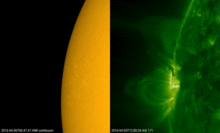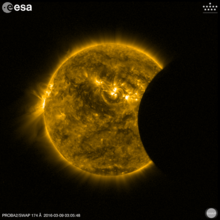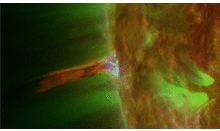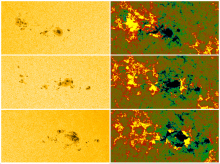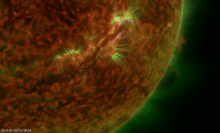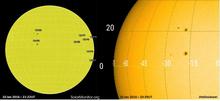news
Submitted on 2016-04-12
Solar activity has been very low over the last weeks, with very few or no C-class flares at all. The x-ray background flux was also low, at or just below the B1 level. Around noon on 5 April, this background flux started a gentle increase to values slightly above B3 on 7 April, coinciding with the appearance of a big sunspot near the solar east limb.

Submitted on 2016-04-05
Solar prominences are clouds of charged particles ("plasma") above the solar surface squeezed between magnetic regions of opposite polarity. Being cooler and denser than the plasma underneath and their surroundings, they appear as bright blobs when seen near the solar limb and as dark lines when seen on the solar disk (then they are called "filaments"). Special filters are required to observe these features, such as in the Hydrogen-alpha (H-alpha) line in the red part of the solar spectrum, or in some extreme ultraviolet (EUV) passbands.
Submitted on 2016-03-31
Continuing the ongoing trend of low solar activity, last week was once again very quiet with flaring levels barely reaching the C-class level. Only NOAA 2524 was able to produce a C1 flare on 23 March (long duration event), and a C2 flare early on Monday 28 March. By then, this active region had decayed into a small single sunspot and was rounding the west limb. Despite its simple outlook, this region showed quite some activity in extreme ultraviolet wavelengths.

Submitted on 2016-03-10
On 2016 March 8 and 9, a solar eclipse took place over the Pacific Ocean. This eclipse was total - that is, the entire solar disk was covered by the Moon- over Indonesia and the central Pacific, starting at sunrise over Sumatra and ending at sunset north of the Hawaiian Islands. Additionally, large parts of South-East Asia, Alaska and Australia witnessed a partial solar eclipse. The path of totality had a maximum width of 155 km and the maximum duration was 4 minutes and 9 seconds at the point of greatest eclipse, which was over the waters of the Pacific Ocean.
Submitted on 2016-02-24When observing the Sun for a prolonged period of time, it soon becomes evident that features on its surface, and in its outer atmosphere do not rotate at the same rate. This is because the Sun is not a solid body, but a big ball of magnetised plasma, whose rotation is variable with position and height in the solar atmosphere.
Submitted on 2016-02-17Once more, two sunspot groups have collided with each other. Indeed, NOAA 2497 was minding its own business when, starting on 11 February, the trailing part of a smaller sunspot group suddenly emerged right in front (to the west; "right") of it. It was unavoidable that the leading part of NOAA 2497 would bump into the trailing part of this new magnetic bipolar region, and it was easy for the space weather forecasters to predict that these developments could result in the production of low-level M-class ("medium") solar flares.
Submitted on 2016-02-09Once again, solar flaring activity has been pretty low. The strongest flare was a C5.1 peaking on 4 February at 18:22UT. The region responsible for this event was NOAA 2494, a sunspot group that was developing near the centre of the solar disk at that time. The region already reached its maximum sunspot area about a day later. It was always smaller than two times the total surface area of the Earth, so considerably smaller than e.g. NOAA 2192.
Submitted on 2016-02-02Solar filaments are clouds of charged particles ("plasma") above the solar surface squeezed between magnetic regions of opposite polarity. Being cooler and denser than the plasma underneath and their surroundings, they appear as dark lines when seen on the solar disk and as bright blobs when seen near the solar limb (then they are called "prominences"). Special filters are required to observe these features, and one such a filter is the Hydrogen-alpha (H-alpha) line in the red part of the solar spectrum.
Submitted on 2016-01-27The phoenix is a large mythological bird with red and gold plumage, which has the most startling ability to regenerate itself. Indeed, when its body becomes old, it disintegrates in a fiery flash, soon to rise from its ashes as a newborn chick. Recently, it was most impressively featured in the Harry Potter movies as Professor Dumbledore's pet.
Pages
Zircon - This is a contributing Drupal Theme
Design by
WeebPal.


